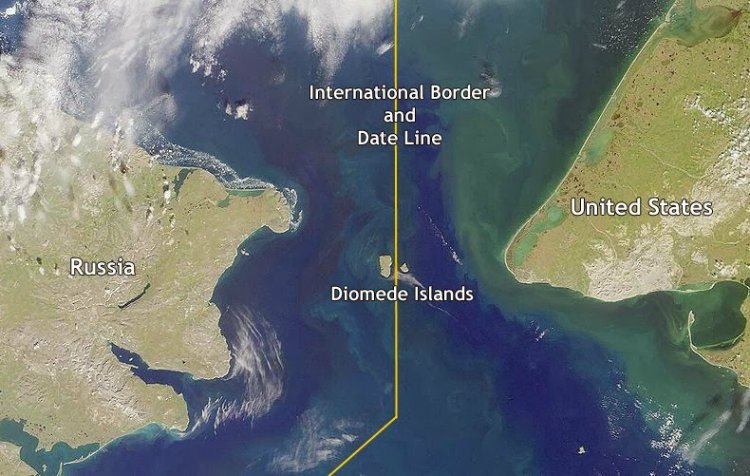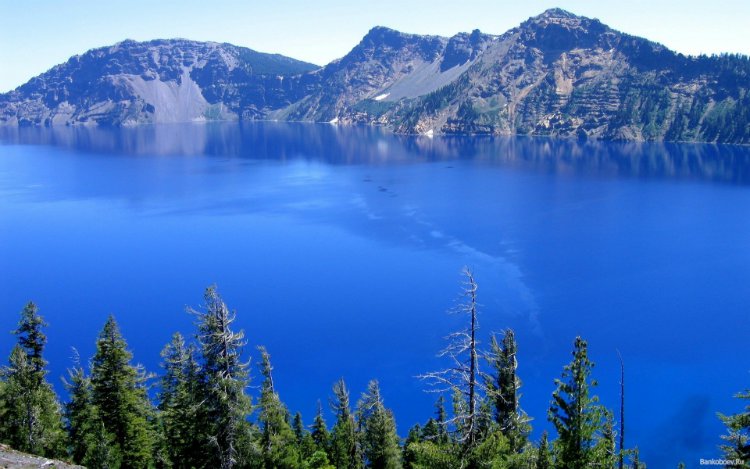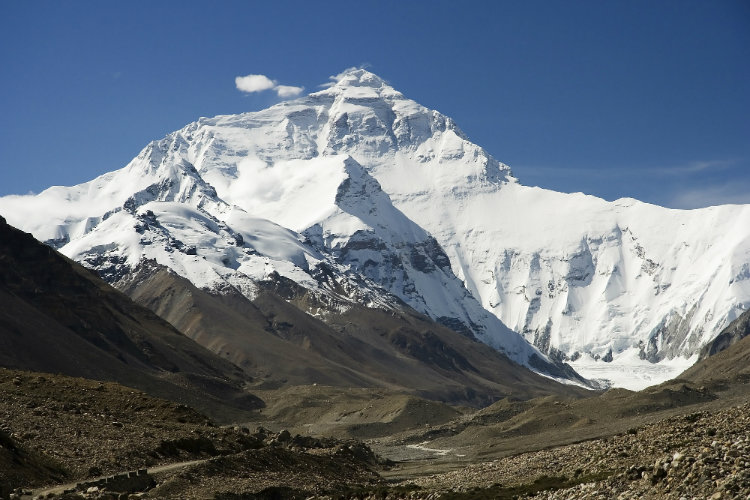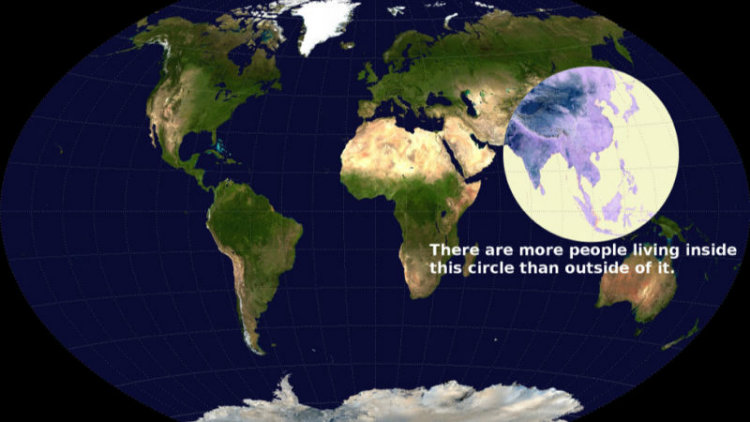Our planet is the best mystery box. In other words, it is filled with many unknown and unusual facts. From the minus temperatures in poles to the scorching heat of equator, from the largest ocean to the smallest island, etc. Geography of this world is more diverse than anyone can imagine. The more we try to unlock its secret, the more anomalies and mysteries we discover. We have brought 10 such mind-boggling geographical facts together.
1. Diomede Islands are constituted of two islands. One is owned by Russia and the other one by America. The distance between both islands is 2.4 miles but the time difference is 21 hours!

Diomede Islands are made up of two islands, the Big Diomede and the Little Diomede. The Big Diomede is under Russian administration while the Little Diomede is under the American administration. The distance between the two islands, which is the closest distance between US and Russia, is just 2.4 miles (3.8km). However, surprisingly these two islands have a time difference of 21 hours. The Big Diomede is 21 hours ahead of LittleDiomede. This large time difference is due to the International Date Line which passes between the two islands. Due to this, Big Diomede is called Tomorrow island and Little Diomede is called Yesterday Island.
2. The Chamarel plain in Mauritius has a small area of sand dunes made up of sand in seven distinct colors.
The Chamarel plain located in the Riviere Noire District of south-western Mauritius is famous all over the world for its Seven colored earth. In fact, it is an area of sand dunes consisting sand that has seven distinct colors. As the sunlight hits the dunes, the seven colors can be seen visibly. The colors of the sand is a result of a difference in cooling of molten volcanic rock. The difference in cooling occurred when the different portions of the molten volcanic rock got cooled at different temperatures. Lastly, the best time to view these colors is the morning when the dew mingled sand brings out its brightest hue.
3. Russia is so large that it spreads over 11 different time zones. When one side of Russia has morning breakfast at 7 am; the other side enjoys evening snacks at 6 pm.
Russia is the largest country in the world. It spreads over 17,075,200 square km area and over 11 time Zones. Thus, the current time range observed by Russia is UTC+02:00 to UTC+12:00. Hence, apparently while one part of Russia enjoys the morning sun, the other part enjoys the sunset.
4. 75% of all fresh water available on earth is stored in the glacier. Also, Lake Baikal in Russia contains 20% of the total non-frozen fresh water available on our planet.
About 15 million square kilometers of land is covered with glacier which is about 10% of the total land area on our planet. If all the glaciers melt, the sea level all over the world would rise by approximately 70 meters. These glaciers contain 75% of total fresh water available in the world.

Lake Baikal in Russia contains 20% of the total non-frozen fresh water available on our planet. It is the oldest and deepest lake in the world and is famous for its crystal clear water. The immense Lake Baikal spreads over an area of 31,722 square kilometers due to which it is often mistaken for a sea. Unfortunately, it is currently under threat due to poaching, pollution, and development.
5. Reelfoot Lake in Tennessee was created due to the impact of three earthquakes, which occurring in 1811 and 1812, measured around 8 on the Richter Scale.
In 1811 and 1812, three earthquakes shook New Madrid. The third earthquake with a magnitude of 7.5 to 8 pushed water into a basin which led to the formation of Reelfoot Lake near Tiptonville, Tennessee.
During these earthquakes, people witnessed that the Mississippi River had started flowing backwards. Yet, scientific studies have shown that the earthquake produced northwest moving water waves which created the illusion that the Mississippi river was flowing backward for a few hours.

6. The Appalachian Mountains are shrinking continuously while the Himalayan Mountains are growing.
The Appalachian Mountain, located in eastern North America, runs from Alabama to New York. It was formed around 480 million years ago. It was once as tall as the Rocky mountains which are located in western North America and their highest peak, Mt. Elbert, is 14,400 feet high. Due to constant rainwater erosion, the Appalachian Mountain is shrinking continuously and its highest peak Mount Mitchell is 6,684 feet high.
The Himalayan Mountains located in Asia between the Indian subcontinent and Tibetan Plateau once used to be as high as the Rocky Mountain. But, now it is even taller and its highest peak, Mount Everest is 29,029 feet high. The Himalayan Mountain range is growing regularly due to the constant collision of India into southern Asia. The Himalayan Mountains are also being eroded by rainwater. However, the rate of erosion is quite small as compared to its rate of growth by the collision. Himalayan Mountain range is currently growing at the rate of 5 mm per year.

7. The Dingo fence in Australia has a length of 3,500 miles which is longer than the distance between Seattle and Miami.
Dingo fence is a 3,500 miles-long fence in Australia that was built in between 1880 to 1885. This fence was built to keep dingoes (Australian wild dogs) out of the southeastern part of Australia where sheep flocks were reared. It is one of the largest man-made structures in the world and is the largest fence in the world. A large part of this fence lies in Queensland where it is known as the Great Barrier Fence or the Wild Dog Barrier Fence.
Currently, it is under the administration of Department of Natural Resources and Water. Twenty-three staff members are employed to look after this fence. A team of two persons patrols 300 km section of this fence once in a week. Some parts of the Dingo Fence are lit at night using fluorescent lamps.
8. The largest ocean in the world, Pacific Ocean, is antipode of itself at some points. There are some points in this massive ocean where if someone takes a dip in the ocean, travels through the core, and comes out on the opposite side, then they would still be in the Pacific Ocean.
With an area of 165.25 million square kilometers, Pacific Ocean is the largest ocean in the World. This massive ocean lies between the US in the east and Asia and Australia in the west. It extends from the Southern Ocean in the south to the Arctic Ocean in the north. Also, the massive Pacific ocean is antipodal at some points making it its own hemisphere. Antipodal, by definition, means points or places in the earth which are diametrically opposite to each other. Therefore, if a person takes a dip in Pacific ocean at that certain point, goes straight through the core and comes out on the other side of the Earth, the person will still be in the Pacific ocean.
9. The Er Wang Dong cave in China and Hang Son Doong cave in Vietnam are so massive that there exists an independent weather system inside it.
Er Wang Dong cave in China is so large that it has its own weather system and vegetation. Its known depth is 441 m. The locals make weather forecast based on the observation from the cave’s entrance, Niubizi tiankeng.
Hang Son Doong cave in Vietnam is located in Laos-Vietnam border. It has the largest known cave passage cross-section in the world. Furthermore, it is so large that it has its own vegetation, fast flowing river, and weather system inside.
10. More than half of the world’s population lives within a circle that covers a proportionally tiny section of the world including China/India/etc. and Southeast Asia.

The circle shown in the image above contains some amazing facts. More than half the population of this world is inside this circle even though the circle is mostly water. Moreover, there are more Hindus, Muslims, and Buddhists inside the circle than outside it. Meanwhile, this densely populated circle contain the most sparsely-populated country on earth, Mongolia.
Source : unbelievable-facts.com

Facebook Comments